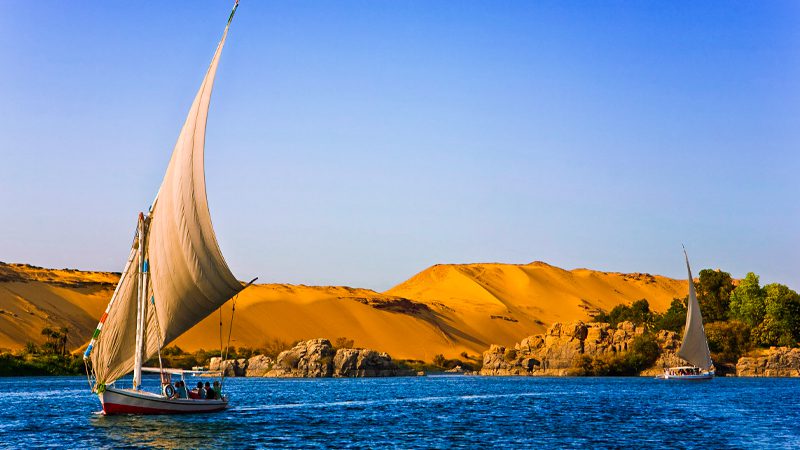Welcome to an extraordinary journey along the Nile, where time seems to stand still and the beauty of ancient Egypt comes to life. In this article, we will delve into the world of Felucca boats, traditional sailing vessels that have graced the waters of the Nile for centuries. Embark on a virtual tour as we unravel the captivating allure of Felucca boat trips, exploring their history, significance, and the unforgettable experiences they offer. Whether you’re a history enthusiast, nature lover, or simply seeking a unique adventure, a Felucca boat excursion promises a fantastic experience on the timeless river that has shaped civilizations.


The Origins and History of Felucca Boats
Felucca boats have been integral to Egyptian history for thousands of years. Originating from ancient Egypt, these sailboats have stood the test of time, maintaining their unique design and traditional construction methods. Dating back to the time of the Pharaohs, feluccas were initially used as cargo vessels, transporting goods along the Nile. Over the centuries, their purpose shifted to recreational sailing, allowing locals and tourists alike to experience the serenity of the river. Today, Felucca boats hold a special place in Egyptian culture and offer a glimpse into the past.
The Significance of Feluccas in Egyptian Culture
Felucca boats are deeply intertwined with Egyptian culture and have become an iconic symbol of the Nile. They represent a connection to the country’s rich heritage and the traditions of its people. The Nile, often called the lifeblood of Egypt, has been the center of civilization for millennia. With their elegant sails and graceful presence, Felucca boats embody the harmony between nature and human existence. These boats are transportation vessels and storytelling platforms where the tales of ancient Egypt and modern adventures merge.
Navigating the Nile: Exploring the Routes
The Nile River offers many routes for felucca boat trips, each with unique charm and attractions. From the bustling city of Cairo to the tranquil landscapes of Aswan, there are endless opportunities to embark on an unforgettable journey. One popular route starts from Luxor, known for its stunning temples and ancient ruins, and sails south towards Aswan, passing by picturesque villages and lush riverbanks.
Alternatively, you can explore the mesmerizing sights of Cairo, taking in the iconic landmarks such as the Pyramids of Giza and the Sphinx, before venturing onto the Nile and immersing yourself in its timeless beauty. The flexibility of Felucca boat trips allows you to tailor your journey to suit your preferences and interests, making each experience unique.
Aboard a Felucca: Anatomy and Design
Felucca boats are crafted with meticulous attention to detail, showcasing the skill and craftsmanship of Egyptian boatbuilders. These traditional vessels feature a simple yet efficient design with a single mast, large triangular sails, and narrow hulls. The sails, typically made of canvas, can be adjusted to harness the wind’s power, propelling the felucca gracefully along the river. The compact size of feluccas creates an intimate and cozy atmosphere, fostering a sense of camaraderie among passengers and crew. Modern adaptations have incorporated comfortable seating areas and additional amenities, ensuring a pleasant and memorable sailing experience.
FAQs related to Felucca boat trips along the Nile:
Are Felucca boat trips suitable for all ages and fitness levels?
Felucca boat trips are generally suitable for all ages and fitness levels. However, it’s essential to consider the duration of the journey and the level of physical activity involved. Some more extended expeditions may require a certain level of stamina and mobility. It’s advisable to check with the tour operator beforehand and communicate any specific concerns or requirements.
What is the best time of year to embark on a Felucca boat trip?
The best time for a Felucca boat trip along the Nile is during the cooler months, typically from October to April. The weather is milder, allowing for a more comfortable sailing experience. It’s important to note that peak tourist seasons, such as December and January, may be busier and require advanced booking. If you prefer a quieter experience, consider visiting during the shoulder seasons of October-November or March-April.
How long do Felucca boat trips typically last?
The duration of Felucca boat trips can vary depending on the chosen itinerary. Day trips or sunset cruises are usually a few hours long, while more extended expeditions can span multiple days. Popular multi-day trips from Luxor to Aswan can range from two to five days, allowing travelers to soak in the sights and immerse themselves in the Nile’s beauty. Reviewing the specific tour details to determine the duration that suits your preferences is essential.
What should I pack for a Felucca boat trip?
When preparing for a Felucca boat trip, it’s advisable to pack essentials such as sunscreen, a hat, sunglasses, comfortable clothing, and insect repellent. As storage space on a Felucca is limited, it’s best to pack light and bring a small backpack or bag that can be easily stowed away. Additionally, don’t forget to bring a refillable water bottle to stay hydrated throughout the journey.
Can I swim in the Nile during a Felucca boat trip?
Swimming in the Nile during a Felucca boat trip can be a memorable experience. However, it’s essential to exercise caution and consult with the boat crew regarding the safety of swimming in specific areas. The team will know the local conditions, currents, and potential hazards. Always follow their instructions and take precautions to ensure a safe and enjoyable swim.
Are Felucca boat trips environmentally friendly and sustainable?
Felucca boat trips align with the principles of responsible tourism and can be considered environmentally friendly. These traditional sailing vessels rely on wind power, reducing the carbon footprint associated with motorized boats. Choosing reputable tour operators who prioritize sustainable practices, such as waste management and minimizing environmental impact, is essential. By supporting such operators, you contribute to preserving the Nile’s ecosystem and the communities that depend on it.
